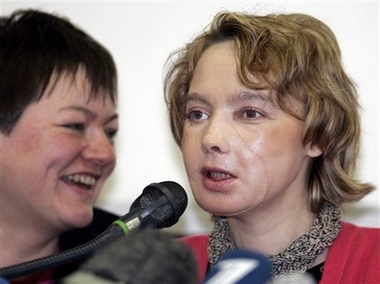Seven months after receiving the world's first partial face transplant, a
French woman continues to improve, doctors said in the first detailed account of
her surgery, published Monday with dramatic before-and-after pictures.
Isabelle Dinoire, 38, was severely disfigured in May 2005 by her pet
Labrador. She received the lips, nose and chin of a brain-dead woman in a
15-hour operation on Nov. 27 in northern France.
|

Isabelle Dinoire, the woman who received the
world's first partial face transplant with part of a nose, chin and lips
on Nov. 27, 2005, addresses reporters during her first appearance at a
press conference since the November surgery at the Amiens Hospital,
northern France, in a Monday Feb. 6, 2006 file photo.
[AP]
|
Doctors said the excellent cosmetic results have surprised not only the
patient but also the entire medical community, and helped justify her doctors'
decision to try the radical surgery.
"It is difficult to conceive that the same degree of success ... would have
been possible with existing techniques" and no transplant, Dr. Patrick Warnke, a
facial surgeon from the University of Kiel in Germany, wrote in a commentary
published online by The Lancet, a British medical journal.
In the same journal, Dr. Bernard Devauchelle at Amiens University details how
he and other surgeons kept the donor face on iced sponges during Dinoire's
surgery as they carefully prepped it and the patient for the procedure.
During surgery, doctors discovered that the donated face lacked a key nerve
that would have helped to animate the lower portion of Dinoire's face.
One week after the transplant, Dinoire could eat and chew, and her speech
improved rapidly. Four months later, sensation had mostly returned, extending to
the edge of one lip.
However, she still cannot move her lower lip or smile very well, and doctors
say she will never be free of the threat of rejection.
She already experienced it once, with the new tissue turning beet red, like a
mask. Big doses of immune-suppressing drugs brought it under control, but she
must take such drugs lifelong to keep from losing her new features.
Doctors removed a flap of skin from the donor's arm and transplanted it under
one of Dinoire's breasts. This allows them to do periodic biopsies to watch for
signs of rejection without scarring her new face.
The operation not only restored her appearance, but also her self-confidence,
so that she's now willing to go out in public again, doctors said.
Before the operation, three psychiatrists agreed with a fourth independent
expert that she was able to psychologically cope with the procedure, Devauchelle
wrote. After the operation, she had psychological evaulations daily for the
first month and then twice a week after that.
Since Dinoire's transplant, the Cleveland Clinic has inched forward with
plans to do a full face transplant, Chinese doctors have done another partial
face transplant, and a panel in England is considering a doctor's request to do
one there.
Devauchelle and colleagues have said they plan to do five more face
transplants but none is imminent.